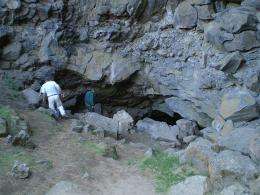Scientists find microbes in lava tube living in conditions like those on Mars

(PhysOrg.com) -- A team of scientists from Oregon has collected microbes from ice within a lava tube in the Cascade Mountains and found that they thrive in cold, Mars-like conditions.
The microbes tolerate temperatures near freezing and low levels of oxygen, and they can grow in the absence of organic food. Under these conditions their metabolism is driven by the oxidation of iron from olivine, a common volcanic mineral found in the rocks of the lava tube. These factors make the microbes capable of living in the subsurface of Mars and other planetary bodies, the scientists say.
The findings, supported by a grant from the National Aeronautics and Space Administration (NASA), are detailed in the journal Astrobiology.
"This microbe is from one of the most common genera of bacteria on Earth," said Amy Smith, a doctoral student at Oregon State University and one of the authors of the study. "You can find its cousins in caves, on your skin, at the bottom of the ocean and just about anywhere. What is different, in this case, is its unique qualities that allow it to grow in Mars-like conditions."
In a laboratory setting at room temperature and with normal oxygen levels, the scientists demonstrated that the microbes can consume organic material (sugar). But when the researchers removed the organic material, reduced the temperature to near-freezing, and lowered the oxygen levels, the microbes began to use the iron within olivine – a common silicate material found in volcanic rocks on Earth and on Mars – as its energy source.
"This reaction involving a common mineral from volcanic rocks just hasn't been documented before," said Martin Fisk, a professor in OSU's College of Earth, Ocean, and Atmospheric Sciences and an author on the study. "In volcanic rocks directly exposed to air and at warmer temperatures, the oxygen in the atmosphere oxidizes the iron before the microbes can use it. But in the lava tube, where the bacteria are covered in ice and thus sheltered from the atmosphere, they out-compete the oxygen for the iron.
"By mimicking those conditions, we got the microbes to repeat that behavior in the laboratory," Fisk added.
The microbes were collected from a lava tube near Newberry Crater in Oregon's Cascades Mountains, at an elevation of about 5,000 feet. They were within the ice on rocks some 100 feet inside the lava tube, in a low-oxygen, near-freezing environment. Scientists, including Fisk, have said that the subsurface of Mars could have similar conditions and harbor bacteria.
In fact, Fisk has examined a meteorite originating from Mars that contained tracks – which could indicate consumption by microbes – though no living material was discovered. Similar tracks were found on the rocks from the Newberry Crater lava tube, he said.
"Conditions in the lava tube are not as harsh as on Mars," Fisk said. "On Mars, temperatures rarely get to the freezing point, oxygen levels are lower and at the surface, liquid water is not present. But water is hypothesized to be present in the warmer subsurface of Mars. Although this study does not exactly duplicate what you would find on Mars, it does show that bacteria can live in similar conditions.
"We know from direct examination, as well as satellite imagery, that olivine is in Martian rocks," Fisk added. "And now we know that olivine can sustain microbial life."
The idea for exploring the lava tube came from Radu Popa, an assistant professor at Portland State University and lead author on the paper. Popa used to explore caves in his native Romania and was familiar with the environmental conditions. Because lava tubes are a sheltered environment and exist on both Earth and Mars, Popa proposed the idea of studying microbes from them to see if life may exist – or could have existed – on the Red Planet.
"When temperatures and atmospheric pressure on Mars are higher, as they have been in the past, ecosystems based on this type of bacteria could flourish," Popa said. "The fingerprints left by such bacteria on mineral surfaces can be used by scientists as tools to analyze whether life ever existed on Mars."
More information: Olivine-Respiring Bacteria Isolated from the Rock-Ice Interface in a Lava-Tube Cave, a Mars Analogue Environment, hdl.handle.net/1957/25386
Provided by Oregon State University













_rdax_300x225.jpg)







